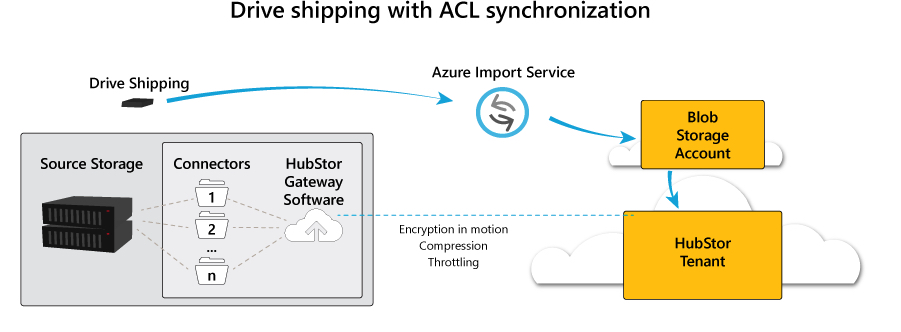HubStor Cloud Archive Adding Support for Microsoft Azure Import Service
With on-premises data security synchronization
This is a Press Release edited by StorageNewsletter.com on March 1, 2017 at 2:38 pmHubStor Inc. announced that clients can now leverage the Azure Import/Export Service to cut down the network bandwidth required to archive large volumes of data to the cloud with HubStor.

HubStor also supports lossless access rights, metadata, and folder structure synchronization for the imported content.
As organizations expand their use of public cloud services, the top enterprise cloud use cases are archiving and data protection. Unstructured data such as documents, images, and videos typically represent 80% of the information a company retains, and most of it is rarely accessed. One of the challenges in using the cloud to preserve and protect legacy data is data migration. Migrating data over a network connection is not always feasible, particularly when connectivity is poor, or the data volume is so large that migrating it would take months.
Using the Azure Import/Export Service, clients can physically ship drives to Microsoft to have their content loaded into a cloud storage account. The problem is when data is copied onto drives, the permissions from the source file system environment are not intact. The drive-shipped data is thus loaded in the cloud without the original access rights, making it difficult to manage the data and impossible to provide self-service access to data owners.
Clients can now use the Azure Import/Export Service to ingest their data into the HubStor cloud archive service and maintain the source access controls. Through its virtual cloud gateway software, the firm offers the option of synchronizing the authorization security with the drive-shipped content after ingestion. It maintains synchronization of data ownership and the permissions on folders and items so that discovery searches and data governance rules are identity-aware in the cloud. The feature also supports enterprise-grade requirements for security and compliance.
“Enterprises face challenges with stockpiles of legacy data, including backup tapes, that simply are not convenient to migrate over the network,” said Greg Campbell, CTO, HubStor. “Our ability to leverage Microsoft’s low-cost Azure Import/Export Service and synchronize the source permissions and other necessary metadata makes the drive-shipping approach feasible for companies with data governance or self-service user access requirements.”
With support for the Azure Import/Export Service, HubStor now offers two data migration methods which its clients can use in parallel. Before, company’s data migration to the cloud was exclusively through its virtual cloud gateway software. Clients run the gateway on-premises to sync and tier data from their existing file servers and NAS to their HubStor tenant running in Azure. The HubStor cloud gateway allows IT professionals to migrate select datasets in place using policies over the network. Data is compressed before transfer, encrypted in motion, and bandwidth throttling features can control the network impact of data transfers during peak and off-peak hours. With drive-shipping, instead of migrating the data over the network, the gateway merely correlates data security attributes, reducing the impact on network bandwidth while delivering a convenient and secure cloud archive.
Blog post by HubStor: Fast-track Cloud Archiving
Read also:
HubStor Expanding Hybrid Cloud Storage With Microsoft Azure
For archiving and offsite data protection with Microsoft Azure
2016.11.24 | Press Release
HubStor Member of Microsoft Enterprise Cloud Alliance
Consumption-based billing to software-as-a-service solution available on Azure
2016.10.26 | Press Release












 Subscribe to our free daily newsletter
Subscribe to our free daily newsletter
